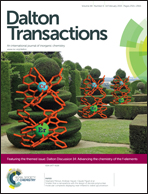Pathogenic properties of Alzheimer's β-amyloid identified from structure–property patient-phenotype correlations†
Abstract
β-Amyloid (Aβ) plays a central role in Alzheimer's disease (AD), but the specific molecular mechanism and associated structures remain unknown. We compiled patient data for carriers of genetic variants of Aβ that cause AD and correlated these data against chemical properties for 56 mutant conformations derived from four published experimental conformations of Aβ of variable structure and chemical environment. Disease onset of variants is significantly (p ∼ 0.006) correlated to hydrophobic surfaces of disordered conformations (2LFM), whereas structured conformations yielded no correlations. Correlation also applied (p < 0.03) to in vitro steady-state Aβ levels. We conclude that disordered monomers are likely to be pathogenically important in contrast to structured conformations and that hydrophobic surface correlates with pathogenesis. This first established correlation between clinical and chemical data suggests that specific exposed, disordered monomers are viable targets for AD therapy.


 Please wait while we load your content...
Please wait while we load your content...